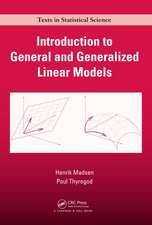Statistical Methods for Geography: A Student’s Guide
Autor Peter A Rogersonen Limba Engleză Hardback – 18 dec 2014
Now fully integrated with online self-assessment exercises and video navigation, it explains everything required to get full credits for any undergraduate statistics module:
- Descriptive statistics, probability, inferential statistics, hypothesis testing and sampling, variance, correlation, regression analysis, spatial patterns, spatial data reduction using factor analysis and cluster analysis.
- Exercises in the text are complemented with online exercise and prompts that test the understanding of concepts and techniques, additional online exercises review understanding of the entire chapter, relating concepts and techniques.
- Completely revised and updated for accessibility, including new material (on measures of distance, statistical power, sample size selection, and basic probability) with related exercises and downloadable datasets.
Preț: 744.64 lei
Preț vechi: 967.06 lei
-23% Nou
Puncte Express: 1117
Preț estimativ în valută:
142.49€ • 147.22$ • 118.53£
142.49€ • 147.22$ • 118.53£
Carte tipărită la comandă
Livrare economică 15-21 martie
Preluare comenzi: 021 569.72.76
Specificații
ISBN-13: 9781446295724
ISBN-10: 1446295729
Pagini: 424
Dimensiuni: 186 x 232 x 27 mm
Greutate: 0 kg
Ediția:Fourth Edition
Editura: SAGE Publications
Colecția Sage Publications Ltd
Locul publicării:London, United Kingdom
ISBN-10: 1446295729
Pagini: 424
Dimensiuni: 186 x 232 x 27 mm
Greutate: 0 kg
Ediția:Fourth Edition
Editura: SAGE Publications
Colecția Sage Publications Ltd
Locul publicării:London, United Kingdom
Recenzii
In this 4th edition of what is now becoming a classic text, Professor Rogerson provides us with the most up-to-date and comprehensive treatment of basic statistics for geographers. He does so in a very user friendly manner with informative, real-world data sets that bring the statistics to life. This is a book I will certainly use for teaching undergraduate statistics and recommend it very highly. A really useful text for which the author is to be congratulated.
At a time where spatial quantitative methods are of increasing importance to all concerned with geographical analysis, Rogerson’s book is a nicely structured, well explained and up-to-date introduction to and survey of statistical methods in geography and the reasoning behind the techniques.
Statistics has become critically important in contemporary geographical analysis. Statistical literacy is one of the graduate attributes with which universities prepare their geography students. Statistical Methods for Geography - A Student’s Guide by Peter A. Rogerson provides a fundamental and accessible statistics textbook tailored for geography with well-designed illustrations and exercises. It is suitable for students of geography at all levels.
In its previous editions, this book provided an outstanding introduction to statistics for geographers or anyone working with geographical data. The explanations of techniques and the examples and practical exercises are all excellent. This latest edition now incorporates material on a number of new topics such as statistical power and ways of measuring distance, and also includes new and timely example datasets from a variety of geographical locations. Its unique breadth of coverage of statistical ideas and examples make this an excellent choice as a key text for teaching quantitative techniques. I have no hesitation in recommending this book.
This book remains the best available guide for any student seeking to use statistical methods to answer the question, ‘where?’. It provides a lucid, comprehensive and practical introduction that will be used widely across geography, and other social and environmental sciences.
At a time where spatial quantitative methods are of increasing importance to all concerned with geographical analysis, Rogerson’s book is a nicely structured, well explained and up-to-date introduction to and survey of statistical methods in geography and the reasoning behind the techniques.
Statistics has become critically important in contemporary geographical analysis. Statistical literacy is one of the graduate attributes with which universities prepare their geography students. Statistical Methods for Geography - A Student’s Guide by Peter A. Rogerson provides a fundamental and accessible statistics textbook tailored for geography with well-designed illustrations and exercises. It is suitable for students of geography at all levels.
In its previous editions, this book provided an outstanding introduction to statistics for geographers or anyone working with geographical data. The explanations of techniques and the examples and practical exercises are all excellent. This latest edition now incorporates material on a number of new topics such as statistical power and ways of measuring distance, and also includes new and timely example datasets from a variety of geographical locations. Its unique breadth of coverage of statistical ideas and examples make this an excellent choice as a key text for teaching quantitative techniques. I have no hesitation in recommending this book.
This book remains the best available guide for any student seeking to use statistical methods to answer the question, ‘where?’. It provides a lucid, comprehensive and practical introduction that will be used widely across geography, and other social and environmental sciences.
Cuprins
Introduction to Statistical Methods for Geography
Descriptive Statistics
Probability and Discrete Probability Distributions
Continuous Probability Distributions and Probability Models
Inferential Statistics: Confidence Intervals, Hypothesis Testing, and Sampling
Analysis of Variance
Correlation
Introduction to Regression Analysis
More on Regression
Spatial Patterns
Some Spatial Aspects of Regression Analysis
Data Reduction: Factor Analysis and Cluster Analysis
Epilogue
Descriptive Statistics
Probability and Discrete Probability Distributions
Continuous Probability Distributions and Probability Models
Inferential Statistics: Confidence Intervals, Hypothesis Testing, and Sampling
Analysis of Variance
Correlation
Introduction to Regression Analysis
More on Regression
Spatial Patterns
Some Spatial Aspects of Regression Analysis
Data Reduction: Factor Analysis and Cluster Analysis
Epilogue
Descriere
Brand-new edition of the essential resource adopted on modules in statistical analysis, statistical methods and quantitative geography worldwide. Now fully integrated with online self-assessment exercises and downloadable data sets.













